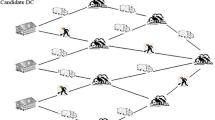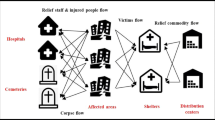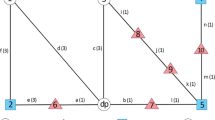Abstract
We develop a multi-period bi-level programming model for the post-disaster road network repair work scheduling and relief logistics problem. A maximum relative satisfaction degree-based steady-state parallel genetic algorithm is designed to solve this model. In order to validate and test the effectiveness of the presented mathematical model and method, we use a network generator to create numerical examples with different scales and characteristics of road network. Our numerical analysis of the solutions shows that the proposed mathematical model and method can effectively assist the decision-makers to deal with the road network repair work scheduling and relief logistics optimization problem during the emergency response phase. This mathematical model and the approach being developed are applied to deal with the case of Wenchuan earthquake in China. The results show that the required CPU time is short enough such that it meets the time limitation in the emergency response phase, and the strategy of road network repair scheduling will allow repair of the damaged roads to be completed before the end of the planning time horizon by 14.93%. Furthermore, the strategy of relief logistics can provide an efficient relief allocation and transportation path.









Similar content being viewed by others
References
Abounacer, R., Rekik, M., & Renaud, J. (2014). An exact solution approach for multi-objective location-transportation problem for disaster response. Computers and Operations Research, 41, 83–93.
Afshar, A., & Haghani, A. (2012). Modeling integrated supply chain logistics in real-time large-scale disaster relief operations. Socio-Economic Planning Sciences, 46(4), 327–338.
Akbari, V., & Salman, F. S. (2017). Multi-vehicle prize collecting arc routing for connectivity problem. Computers and Operations Research, 82, 52–68.
Akbari, V., & Salman, F. S. (2017). Multi-vehicle synchronized arc routing problem to restore post-disaster network connectivity. European Journal of Operational Research, 257(2), 625–640.
Aksu, D. T., & Ozdamar, L. (2014). A mathematical model for post-disaster road restoration: Enabling accessibility and evacuation. Transportation Research Part E: Logistics and Transportation Review, 61, 56–67.
Altiparmak, F., Gen, M., Lin, L., & Karaoglan, I. (2009). A steady-state genetic algorithm for multi-product supply chain network design. Computers and Industrial Engineering, 56(2), 521–537.
Beresford, A., & Pettit, S. (2012). Humanitarian aid logistics: The wenchuan and haiti earthquakes compared. In Relief supply chain management for disasters: Humanitarian aid and emergency logistics, 1st ed. Hershey, PA: IGI Global
Berger, J., & Barkaoui, M. (2004). A parallel hybrid genetic algorithm for the vehicle routing problem with time windows. Computers and Operations Research, 31(12), 2037–2053.
Berkoune, D., Renaud, J., Rekik, M., & Ruiz, A. (2012). Transportation in disaster response operations. Socio-Economic Planning Sciences, 46(1), 23–32.
Boonmee, C., Arimura, M., & Asada, T. (2017). Facility location optimization model for emergency humanitarian logistics. International Journal of Disaster Risk Reduction, 24, 485–498.
Bozorgi-Amiri, A., & Khorsi, M. (2016). A dynamic multi-objective location-routing model for relief logistic planning under uncertainty on demand, travel time, and cost parameters. The International Journal of Advanced Manufacturing Technology, 85(5–8), 1633–1648.
Camacho-Vallejo, J. F., González-Rodríguez, E., Almaguer, F. J., & González-Ramírez, R. G. (2015). A bi-level optimization model for aid distribution after the occurrence of a disaster. Journal of Cleaner Production, 105, 134–145.
Çelik, M. (2016). Network restoration and recovery in humanitarian operations: Framework, literature review, and research directions. Surveys in Operations Research and Management Science, 21(2), 47–61.
Çelik, M., Ergun, Ö., & Keskinocak, P. (2015). The post-disaster debris clearance problem under incomplete information. Operations Research, 63(1), 65–85.
Chang, M. S., & Li, D. C. (2010). A sampling-based approximation method applied to stochastic real-time emergency rehabilitation scheduling problem. International Journal of Intelligent Transportation Systems Research, 8(1), 42–55.
Chang, S. E., & Nojima, N. (2001). Measuring post-disaster transportation system performance: The 1995 kobe earthquake in comparative perspective. Transportation Research Part A: Policy and Practice, 35(6), 475–494.
Chen, Y. W., & Tzeng, G. H. (1999). A fuzzy multi-objective model for reconstructing the post-quake road-network by genetic algorithm. International Journal of Fuzzy Systems, 1(2), 85–95.
Chen, Y., Tadikamalla, P. R., Shang, J., & Song, Y. (2017). Supply allocation: Bi-level programming and differential evolution algorithm for natural disaster relief. Cluster Computing. https://doi.org/10.1007/s10586-017-1366-6.
Cho, S. H., Jang, H., Lee, T., & Turner, J. (2014). Simultaneous location of trauma centers and helicopters for emergency medical service planning. Operations Research, 62(4), 751–771.
Colson, B., Marcotte, P., & Savard, G. (2007). An overview of bilevel optimization. Annals of Operations Research, 153(1), 235–256.
Duhamel, C., Santos, A. C., Brasil, D., Châtelet, E., & Birregah, B. (2016). Connecting a population dynamic model with a multi-period location-allocation problem for post-disaster relief operations. Annals of Operations Research, 247(2), 693–713.
Duque, P. A. M., Coene, S., Goos, P., Sörensen, K., & Spieksma, F. (2013). The accessibility arc upgrading problem. European Journal of Operational Research, 224(3), 458–465.
Duque, P. M., & Sörensen, K. (2011). A grasp metaheuristic to improve accessibility after a disaster. OR Spectrum, 33(3), 525–542.
Elluru, S., Gupta, H., Kaur, H., & Singh, S. P. (2017). Proactive and reactive models for disaster resilient supply chain. Annals of Operations Research. https://doi.org/10.1007/s10479-017-2681-2.
Fahimnia, B., Jabbarzadeh, A., Ghavamifar, A., & Bell, M. (2017). Supply chain design for efficient and effective blood supply in disasters. International Journal of Production Economics, 183, 700–709.
Feng, C., & Wang, T. (2005). Seismic emergency rehabilitation scheduling for rural highways. Transportation Planning Journal, 34(2), 177–210.
Feng, C. M., & Wang, T. C. (2003). Highway emergency rehabilitation scheduling in post-earthquake 72 hours. Journal of the 5th Eastern Asia Society for Transportation Studies, 5, 3276–3285.
Ferrer, J. M., Martín-Campo, F. J., Ortuño, M. T., Pedraza-Martínez, A. J., Tirado, G., & Vitoriano, B. (2018). Multi-criteria optimization for last mile distribution of disaster relief aid: Test cases and applications. European Journal of Operational Research, 269(2), 501–515.
Floyd, R. W. (1962). Algorithm 97: Shortest path. Communications of the ACM, 5(6), 345.
Gama, M., Santos, B. F., & Scaparra, M. P. (2016). A multi-period shelter location-allocation model with evacuation orders for flood disasters. EURO Journal on Computational Optimization, 4(3–4), 299–323.
Gutjahr, W. J., & Dzubur, N. (2016). Bi-objective bilevel optimization of distribution center locations considering user equilibria. Transportation Research Part E: Logistics and Transportation Review, 85, 1–22.
Hasani, A., & Mokhtari, H. (2018). Redesign strategies of a comprehensive robust relief network for disaster management. Socio-Economic Planning Sciences. https://doi.org/10.1016/j.seps.2018.01.003.
Holguín-Veras, J., Pérez, N., Jaller, M., Van Wassenhove, L. N., & Aros-Vera, F. (2013). On the appropriate objective function for post-disaster humanitarian logistics models. Journal of Operations Management, 31(5), 262–280.
Hong, J. D., Jeong, K. Y., & Feng, K. (2015). Emergency relief supply chain design and trade-off analysis. Journal of Humanitarian Logistics and Supply Chain Management, 5(2), 162–187.
Ibri, S., Nourelfath, M., & Drias, H. (2012). A multi-agent approach for integrated emergency vehicle dispatching and covering problem. Engineering Applications of Artificial Intelligence, 25(3), 554–565.
Jabbarzadeh, A., Fahimnia, B., & Seuring, S. (2014). Dynamic supply chain network design for the supply of blood in disasters: a robust model with real world application. Transportation Research Part E: Logistics and Transportation Review, 70, 225–244.
Karamlou, A., & Bocchini, P. (2014). Optimal bridge restoration sequence for resilient transportation networks. Structures Congress, 2014, 1437–1447.
Kasaei, M., & Salman, F. S. (2016). Arc routing problems to restore connectivity of a road network. Transportation Research Part E: Logistics and Transportation Review, 95, 177–206.
Klingman, D., Napier, A., & Stutz, J. (1974). Netgen: A program for generating large scale capacitated assignment, transportation, and minimum cost flow network problems. Management Science, 20(5), 814–821.
Lenstra, J. K., & Kan, A. (1981). Complexity of vehicle routing and scheduling problems. Networks, 11(2), 221–227.
Li, A. C., Nozick, L., Xu, N., & Davidson, R. (2012). Shelter location and transportation planning under hurricane conditions. Transportation Research Part E: Logistics and Transportation Review, 48(4), 715–729.
Li, Q., Tu, W., & Zhuo, L. (2018). Reliable rescue routing optimization for urban emergency logistics under travel time uncertainty. ISPRS International Journal of Geo-Information, 7(2), 77–97.
Liberatore, F., Ortuño, M. T., Tirado, G., Vitoriano, B., & Scaparra, M. P. (2014). A hierarchical compromise model for the joint optimization of recovery operations and distribution of emergency goods in humanitarian logistics. Computers and Operations Research, 42, 3–13.
Lin, Y. H., Batta, R., Rogerson, P. A., Blatt, A., & Flanigan, M. (2012). Location of temporary depots to facilitate relief operations after an earthquake. Socio-Economic Planning Sciences, 46(2), 112–123.
Maharjan, R., & Hanaoka, S. (2018). A multi-actor multi-objective optimization approach for locating temporary logistics hubs during disaster response. Journal of Humanitarian Logistics and Supply Chain Management, 8(1), 2–21.
Manopiniwes, W., & Irohara, T. (2017). Stochastic optimisation model for integrated decisions on relief supply chains: Preparedness for disaster response. International Journal of Production Research, 55(4), 979–996.
Maya-Duque, P. A., Dolinskaya, I. S., & Sörensen, K. (2016). Network repair crew scheduling and routing for emergency relief distribution problem. European Journal of Operational Research, 248(1), 272–285.
Mejia-Argueta, C., Gaytán, J., Caballero, R., Molina, J., & Vitoriano, B. (2018). Multicriteria optimization approach to deploy humanitarian logistic operations integrally during floods. International Transactions in Operational Research, 25(3), 1053–1079.
Mimura, N., Yasuhara, K., Kawagoe, S., Yokoki, H., & Kazama, S. (2011). Damage from the great east japan earthquake and tsunami-a quick report. Mitigation and Adaptation Strategies for Global Change, 16(7), 803–818.
Mollah, A. K., Sadhukhan, S., Das, P., & Anis, M. Z. (2017). A cost optimization model and solutions for shelter allocation and relief distribution in flood scenario. International Journal of Disaster Risk Reduction. https://doi.org/10.1016/j.ijdrr.2017.11.018.
Najafi, M., Eshghi, K., & Dullaert, W. (2013). A multi-objective robust optimization model for logistics planning in the earthquake response phase. Transportation Research Part E: Logistics and Transportation Review, 49(1), 217–249.
Noyan, N., & Kahvecioğlu, G. (2018). Stochastic last mile relief network design with resource reallocation. OR Spectrum, 40(1), 187–231.
Özdamar, L., Aksu, D. T., & Ergüneş, B. (2014). Coordinating debris cleanup operations in post disaster road networks. Socio-Economic Planning Sciences, 48(4), 249–262.
Ozdamar, L., Aksu, D. T., Yasa, E., & Ergunes, B. (2018). Disaster relief routing in limited capacity road networks with heterogeneous flows. Journal of Industrial & Management Optimization, 12(5), 327–338. https://doi.org/10.3934/jimo.2018011.
Özdamar, L., & Demir, O. (2012). A hierarchical clustering and routing procedure for large scale disaster relief logistics planning. Transportation Research Part E: Logistics and Transportation Review, 48(3), 591–602.
Özdamar, L., & Ertem, M. A. (2015). Models, solutions and enabling technologies in humanitarian logistics. European Journal of Operational Research, 244(1), 55–65.
PAHO: Natural disasters: Protecting the public’s health. Tech. rep., Pan American Health Organization (2000)
Rath, S., & Gutjahr, W. J. (2014). A math-heuristic for the warehouse location-routing problem in disaster relief. Computers and Operations Research, 42, 25–39.
Rawls, C. G., & Turnquist, M. A. (2010). Pre-positioning of emergency supplies for disaster response. Transportation Research Part B: Methodological, 44(4), 521–534.
Ren, X., Zhu, J., & Huang, J. (2012). Multi-period dynamic model for emergency resource dispatching problem in uncertain traffic network. Systems Engineering Procedia, 5, 37–42.
Rezaei-Malek, M., Tavakkoli-Moghaddam, R., Zahiri, B., & Bozorgi-Amiri, A. (2016). An interactive approach for designing a robust disaster relief logistics network with perishable commodities. Computers and Industrial Engineering, 94, 201–215.
Safaei, A. S., Farsad, S., & Paydar, M. M. (2018). Emergency logistics planning under supply risk and demand uncertainty. Operational Research. https://doi.org/10.1007/s12351-018-0376-3.
Sato, T., & Ichii, K. (1996). Optimization of post-earthquake restoration of lifeline networks using genetic algorithms. In Proceedings Japan Society of Civil Engineers (Vol. 537, pp. 245–256). Dotoku Gakkai. https://doi.org/10.2208/jscej.1996.537_245.
Sha, Y., & Huang, J. (2012). The multi-period location-allocation problem of engineering emergency blood supply systems. Systems Engineering Procedia, 5, 21–28.
Sheu, J. B. (2007). An emergency logistics distribution approach for quick response to urgent relief demand in disasters. Transportation Research Part E: Logistics and Transportation Review, 43(6), 687–709.
Tamura, T., Sugimoto, H., & Kamimae, T. (1994). Application of genetic algorithms to determining priority of urban road improvement. In Proceedings Japan society of civil engineers, pp. 37–37. DOTOKU GAKKAI
Tang, C. H., Yan, S., & Chang, C. W. (2009). Short-term work team scheduling models for effective road repair and management. Transportation Planning and Technology, 32(3), 289–311.
Tayal, A., Gunasekaran, A., Singh, S. P., Dubey, R., & Papadopoulos, T. (2017). Formulating and solving sustainable stochastic dynamic facility layout problem: A key to sustainable operations. Annals of Operations Research, 253(1), 621–655.
Tayal, A., & Singh, S. (2014). Chaotic simulated annealing for solving stochastic dynamic facility layout problem. Journal of International Management Studies, 14(2), 67–74.
Tayal, A., & Singh, S. P. (2016). Integrating big data analytic and hybrid firefly-chaotic simulated annealing approach for facility layout problem. Annals of Operations Research. https://doi.org/10.1007/s10479-016-2237-x.
Teo, K. L., & Yang, X. (2001). Portfolio selection problem with minimax type risk function. Annals of Operations Research, 101(1–4), 333–349.
Trunick, P. (2005). Special report: delivering relief to tsunami victims. Logistics Today, 46(2), 1–3.
Vahdani, B., Veysmoradi, D., Shekari, N., & Mousavi, S. M. (2018). Multi-objective, multi-period location-routing model to distribute relief after earthquake by considering emergency roadway repair. Neural Computing and Applications, 30(3), 835–854. https://doi.org/10.1007/s00521-016-2696-7.
Wex, F., Schryen, G., Feuerriegel, S., & Neumann, D. (2014). Emergency response in natural disaster management: Allocation and scheduling of rescue units. European Journal of Operational Research, 235(3), 697–708.
Wohlgemuth, S., Oloruntoba, R., & Clausen, U. (2012). Dynamic vehicle routing with anticipation in disaster relief. Socio-Economic Planning Sciences, 46(4), 261–271.
Yahyaei, M., & Bozorgi-Amiri, A. (2018). Robust reliable humanitarian relief network design: An integration of shelter and supply facility location. Annals of Operations Research. https://doi.org/10.1007/s10479-018-2758-6.
Yan, S., & Shih, Y. L. (2009). Optimal scheduling of emergency roadway repair and subsequent relief distribution. Computers and Operations Research, 36(6), 2049–2065.
Yan, S., & Shih, Y. L. (2012). An ant colony system-based hybrid algorithm for an emergency roadway repair time-space network flow problem. Transportmetrica, 8(5), 361–386.
Yu, L., Yang, H., Miao, L., & Zhang, C. (2017). Rollout algorithms for resource allocation in humanitarian logistics. IISE Transactions,. https://doi.org/10.1080/24725854.2017.1417655.
Yu, L., Zhang, C., Yang, H., & Miao, L. (2018). Novel methods for resource allocation in humanitarian logistics considering human suffering. Computers and Industrial Engineering, 119, 1–20.
Zahiri, B., Tavakkoli-Moghaddam, R., & Pishvaee, M. S. (2014). A robust possibilistic programming approach to multi-period location-allocation of organ transplant centers under uncertainty. Computers and Industrial Engineering, 74, 139–148.
Zhan, Sl, Liu, N., & Ye, Y. (2014). Coordinating efficiency and equity in disaster relief logistics via information updates. International Journal of Systems Science, 45(8), 1607–1621.
Zhang, W., Wang, N., & Nicholson, C. (2017). Resilience-based post-disaster recovery strategies for road-bridge networks. Structure and Infrastructure Engineering, 13(11), 1404–1413.
Zhao, M., & Liu, X. (2018). Development of decision support tool for optimizing urban emergency rescue facility locations to improve humanitarian logistics management. Safety Science, 102, 110–117.
Zheng, Y. J., & Ling, H. F. (2013). Emergency transportation planning in disaster relief supply chain management: A cooperative fuzzy optimization approach. Soft Computing, 17(7), 1301–1314.
Zhou, Y., Liu, J., Zhang, Y., & Gan, X. (2017). A multi-objective evolutionary algorithm for multi-period dynamic emergency resource scheduling problems. Transportation Research Part E: Logistics and Transportation Review, 99, 77–95.
Acknowledgements
This paper is supported by National Natural Science Foundation of China (Grant No. 71502059), Hunan Provincial Natural Science Foundation of China (Grant No. 2016JJ3091), and Educational Department of Hunan Province of China (Grant No. 16B169). Additionally, this work is partially sponsored by China Scholarship Council (No. 201706725018). Special thanks are due to this work is supported by resources provided by the Pawsey Supercomputing Centre with funding from the Australian Government and the Government of Western Australia, and the Laboratory High-Performance Computing and Stochastic Information Processing (HPCSIP) of Hunan Normal University, Changsha, China.
Author information
Authors and Affiliations
Corresponding author
Appendix A: Detail information for case study
Appendix A: Detail information for case study
The detail information for supply depots and demand nodes are shown in Table 16, where \(S_{m}^{\tau }\) is determined by the capacity of the distribution center \(m \in N_{s}^{\tau }\) and \(D_{n}^{\tau }\) is determined by the number of people in accordance with the Statistical Yearbook 2008, Sichuan, and the percentage of the collapsed houses that can be predicted by satellite images, infrared and aerial photography technology. In addition, the traverse time for each road/link is available from google earth.
The damaged nodes detail information are shown in Table 17, where \(s_{d}, d \in N_{r}^{\tau }\) is the required repair time in minutes, which is forecasted using the technology of infrared or aerial photography. Namely, we first get the length of destroyed roads/links each of the damaged nodes by using the technology of infrared or aerial photography, then it is divided by the capability of each repair crew. In this paper, we assume that the capability of each of the repair crew is the same and equals to 0.5 Km/h.
In Table 18, the number of vehicles and the occupied OD are obtained from the data of Public Road Bureau, Department of Transportation of Sichuan Province, China.
Rights and permissions
About this article
Cite this article
Li, S., Teo, K.L. Post-disaster multi-period road network repair: work scheduling and relief logistics optimization. Ann Oper Res 283, 1345–1385 (2019). https://doi.org/10.1007/s10479-018-3037-2
Published:
Issue Date:
DOI: https://doi.org/10.1007/s10479-018-3037-2




